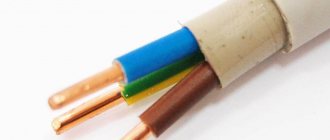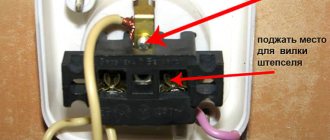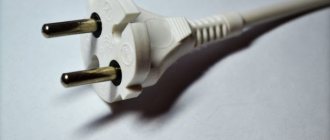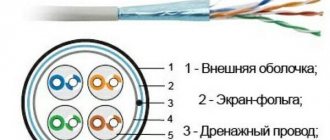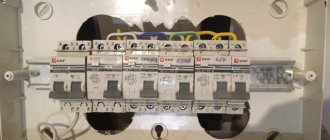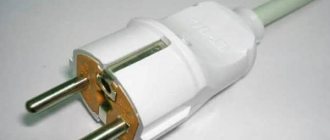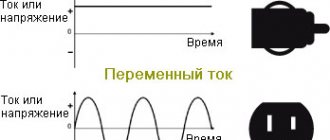Using household appliances involves the daily actions of connecting plugs of household appliances to electrical outlets and disconnecting them from the power supply. These processes have become so deeply ingrained in people’s consciousness that in almost one hundred percent of cases we do it automatically, without thinking about the essence of the process. However, in practice, most people make mistakes when using electrical appliances, because the plug must be inserted and removed correctly into the socket.
How to remove the child lock from the socket?
If you no longer need child protection, then there is a very easy way to remove the child protection on the outlet. Just plug the adapter into the outlet. You can also unscrew the socket. Be sure to turn off the power first.
Interesting materials:
How to glue a piece of wallpaper onto wallpaper? How to join a clinic using compulsory medical insurance? How to lure Sparrows to the feeder? How to try on clothes in Lamoda? How to apologize to a client? How to take part in the project I'm embarrassed about my body? How to take hawthorn for the heart? How to take Isoptin? How to take medicine between meals? How to take Rivotril?
Some important rules
Proper use of electrical appliances and plugs also includes keeping them off-grid during non-working hours. Any electrical appliance plugged into an outlet consumes electricity, albeit a minimal amount. In addition, constant voltage, as well as all kinds of external factors: lightning during a thunderstorm or voltage surges in the general network, can cause problems and equipment breakdowns, as well as pose a threat to your home. In this regard, it is strongly recommended to disconnect devices from the power supply in case of prolonged inactivity. This primarily applies to large household appliances and appliances that consume large amounts of energy: electric kettles, microwave ovens, etc.
To disconnect the plug from the network every time, you can purchase special network adapters that have a power disconnect button.
Careful and correct use of electrical appliances and elements of the electrical network, as well as the installation of high-quality products that meet modern standards, will help not only improve the quality of life, but also avoid troubles and risks for equipment and the health of users.
Wiring
Any electrical circuit consists of wires and their connections. So, most often it is the connection points of the wires, namely: distribution boxes, terminal blocks, sockets, plugs, switches, connection points for chandeliers and lamps, connection of sockets and contact of the socket with the lamp - these are the weak points in the wiring. Why contacts? Let's start from afar: The goal of high-quality installation of electrical wiring is to “deliver” the required amount of electricity to the electrical device with minimal losses and safely. These losses occur due to the resistance of the circuit (wires and their connections). For clarity, let’s take a wheel with an unlubricated bearing: it spins with difficulty due to friction and when rotating, the wheel heats up, that is, part of the energy spent on rotation goes into heat. The same thing happens when an electric current passes through a conductor, and the greater the resistance of a section of the circuit (friction between the current and the conductor) , the more it will heat up . The second thing that can cause heating is too much current density in the circuit or in its section. Let’s imagine how water is drained in a bathroom: with low pressure, the water manages to flow into the sewer. As the flow increases, a limit may be reached at which the water will not have time to flow out and the bath will slowly fill with water. The same thing will happen if the drain becomes clogged. It is at the site of the blockage that water will accumulate.
If we put this situation into the electrical aspect, we can say this: the wire or connection of wires (contact) will not have time to pass all the current through itself, as a result of which it will heat up. Similar to a clogged sewer. In some cases, the heating temperature may be sufficient to melt the insulation, which can lead to a short-circuit between the two wires. To prevent this from happening, you need to select the correct cross-section of wires and circuit breakers.
What does connection actually look like in modern realities?
Considering the complexity of work in the bathroom, our people have come up with several ways to circumvent the ban.
- Buy a personal extension cord for only one device. In fact, another socket is also a kind of carrier, but laid in the wall according to all the rules of science.
- Carrying must be of high quality and grounded! Some people make their own, while others buy them in a store. For example, it has proven itself well. Its carriers are equipped with protection; in the event of a power outage or overheating, the device will turn off and prevent expensive equipment from burning out.
- Extend the cord to the required length. But here pitfalls emerge in the form of constant exposure of the door to the wire. It will gradually wear out and there will be a risk of short circuit, electric shock or fire.
The best way is to conduct grounded wiring from the panel directly to the bathroom and not worry!
Typical malfunctions of electrical plugs and methods for eliminating them
Plug malfunctions can result from their incorrect use. Any problem is easy to detect in the early stages.
| Malfunction | Signs of a problem | Repair methods |
| Carbon deposits on conductive pins | The pins get hot. Covered with black coating, soot and oxide. Sometimes craters and traces of pin melting are formed. | If there are no craters and there is just soot on the pins, it is enough to clean them with sandpaper. If the pins have melted and have craters with a diameter of more than 2 mm, it is advisable to replace the plug with a new one. |
| Poor contact between conductive pin and wire | The fork, when working under load, cracks and emits a characteristic burning smell. | It is necessary to open the plug and clean the burnt parts with sandpaper. Then securely screw the wires to the cleaned contacts and reassemble them to their original state. It is better to bite off the burnt ends of the wires. |
| Broken wire | If you move the wire at the bend, the contact disappears. This often happens with a vacuum cleaner, drill and other portable equipment. | It is necessary to cut out the section of the cable with a break. |
| Hull destruction | The plug body falls apart when pressed with fingers. | The plug should be replaced with a new one. The probable cause is overheating. It is necessary to additionally check the condition of the outlet. |
Important! If the pins burn, you need to check the lamellas in the socket. With a high probability they overheat and are in disrepair. Do not use overheated plugs or sockets. Heating can cause a fire in the wiring.
The main signs of a faulty socket
Every person in his life has encountered situations when, when turning on a household appliance, strange things began to happen.
These include a strange crackling sound, slight smoke or a bright flash, after which the light in the room completely disappears. A melted body and an unpleasant burning smell also serve as a signal of a malfunction.
In such cases, along with the socket, the fuses of the device may be damaged, the wiring may be damaged, and even the microcircuits of household appliances may burn out. In most cases, you can protect yourself from the consequences of a short circuit thanks to automatic protection in the electrical panel.
But you shouldn’t hope and rely on it 100%, because... By analogy with other devices, a machine tends to wear out and burn out.
If problems are detected in the operation of the outlet, you must immediately remove the load by disconnecting the household appliance from the power supply and begin troubleshooting and solving problems.
To make sure that the socket is really damaged, the first thing you need to do is connect an electrical appliance to it, the correct operation of which there is no doubt.
If a normally functioning lamp, for example, does not operate normally when connected to this point, measures must be taken to eliminate the breakdown.
Initial inspection of the outlet
There are several options to determine the type of fault in the connector. The very first is a visual inspection of the front of the outlet for external defects.
Since the front side of the socket is made of plastic, there is a possibility of cracks during use. More serious damage may include traces of soot or melted connector holes.
There are three main reasons for socket melting:
- The load current is higher than the capabilities of the device or wiring. When a power flow flows through a channel that is narrow for it, its density naturally increases. As a result, the load increases, then overheating occurs. In such cases, the socket must be replaced with a new device with suitable characteristics.
- The insulation of the conductors in the area connected to the socket mechanism is broken. The reason lies in non-compliance with the installation technology of the device, cuts and damage to the insulation due to clumsy actions. You need to replace a melted socket with a device with equivalent characteristics, not forgetting to remove damaged sections of wires.
- Problems with contacts. They could simply oxidize or weaken. The problem is solved by stripping or tightening.
Water got into your MacBook
Sometimes laptops are delivered even in this condition
What is the sequence of actions if water or other liquid gets into the MacBook? You still need to get to the service center. What to do first?
Let's say right away - please do not put your laptop in rice, do not try to disassemble it or dry it with a hairdryer. If you really want to minimize the damage, first of all, unplug your MacBook from charging (for some reason many people don’t do this), disconnect all connected accessories such as flash drives, monitor cables and adapters.
Then lay out a towel and place the laptop with the keyboard facing down - this may help get rid of some of the liquid. It is better to perform these actions while you are getting dressed to go and show the device to specialists. Every minute counts here. If possible, bring your MacBook to the service center in the same position (keyboard down, with a towel or napkin).
If you put such a MacBook on a towel, there will be many benefits
What if this is not done? What could be the consequences of water getting into a MacBook?
If you just wipe the laptop and continue to use it, it can even work for several days (and more if very little liquid has entered). But then you shouldn’t be surprised when the computer suddenly turns off. Due to the ingress of moisture, corrosion occurs and in the future it is necessary to replace damaged microcircuits in a service center. There have been cases where the water damage was so severe that the entire motherboard had to be replaced. This repair is not cheap, although it is possible.
Even after short contact with water, oxides appear on the board
Prompt intervention by specialists will help minimize the damage; in our practice, there have been times when it was enough to simply clean the laptop after water got in, since the owner quickly brought it to the service center. It is in the user's best interest to pay less for repairs. You don’t self-medicate and continue to work if you seriously injured your leg, do you? It's the same here.
What types of forks are there?
Before replacing the plug, you need to find out its type. There are devices in which it is permissible to use only grounding plugs. For example, washing machines, microwave ovens, irons. In other devices, a simple plug without a third contact will do.
Depending on the structure, maximum current and the presence of grounding, plugs are conventionally divided into the following types:
- collapsible models;
- non-separable;
- with grounding;
- without grounding;
- ordinary;
- corresponding to the European standard.
Types of electrical plugs
Different size
The most common types of plugs for electrical appliances in our country are:
- C1-b are the familiar old collapsible forks. The base is twisted from 2 plastic halves. Pin diameter 4 mm, device power up to 6A, without grounding;
- C5 - the situation is the same as with the previous copy, only the body is cast, the fork cannot be disassembled. Pins with a diameter of 4 mm, power up to 6A;
- C6 - plug diameter 4.8 mm, device power up to 10A, can be equipped with a grounding element.
As can be seen from the sizes, plugs C1 and C5 will fit perfectly into both old and new sockets. But the C6 plug will not fit into the old socket.
If you do not want to change the socket, then simply saw the holes in the old one with a needle file, after first removing the plate from the wall. It should be remembered that you can plug in a device into the outlet that exceeds its rated power, which will have negative consequences over time.
Uncover the terrible secret of modern sockets
Enter or register. Search messages New messages Latest activity Help. Why does the socket clamp the plug? On the forum since: June 17 Messages: Likes: 8 Points:
Register Login. Mail replies. Questions - leaders Help please! Microsoft Word doesn't work! The laptop does not turn off completely 1 rate.
Results: 7. Exact matches: 7. Time spent: 40 ms.
Address: Dubravnaya street, 13, Gorki-3 microdistrict, Kazan, Republic of Tatarstan, Russia

